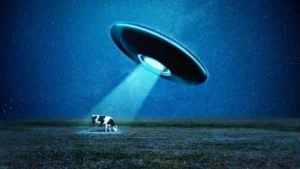I still remember the moment—my nephew, aged six, looked up one evening and asked with wide eyes, “Why is the sky blue and not green?” Caught off guard, I gave him a basic explanation about sunlight and scattering. But that innocent question stuck with me. What if the sky was green instead of blue? Would life look different? Would we behave differently? Would it even be possible?
That single question opened a door to an unexpected world of science, perception, and what-ifs. In this article, we explore not just why the sky is blue—but what might happen if nature coloured it green instead. Backed by atmospheric science, colour theory, and a bit of imagination, this is a journey through one of nature’s biggest visual features: our sky.
Why Is the Sky Blue in the First Place?
Before we imagine a green sky, it’s worth understanding why our sky is blue.
When sunlight reaches Earth’s atmosphere, it collides with air molecules. These collisions scatter the light in all directions. This process is called Rayleigh scattering, named after the 19th-century British physicist Lord Rayleigh.
Shorter wavelengths of light (blue and violet) scatter more than longer wavelengths (like red and yellow). Our eyes, however, are more sensitive to blue and less to violet. So, the sky appears blue to the human eye.
Quick Science Snapshot:
- Violet light scatters more, but our eyes filter most of it.
- Blue light hits the sweet spot of scattering and visibility.
- At sunrise and sunset, light travels through more atmosphere, so reds and oranges dominate due to minimal scattering.
Now, let’s flip the script.
What Would Cause a Green Sky?
For the sky to appear green, something fundamental would need to change in the way sunlight interacts with our atmosphere.
Here are three possible scenarios:
1. Different Atmospheric Composition
If our atmosphere had a different mix of gases—perhaps more methane or other particles that scatter green wavelengths more efficiently—we might perceive a green sky.
According to Dr. Monica Grady, Professor of Planetary and Space Sciences at the Open University, “Planetary atmospheres elsewhere in the solar system, like on Uranus and Neptune, show different hues due to their gas compositions and how light interacts with them.”
For Earth, a green sky would suggest a shift in dominant scattering wavelengths—a fundamental shift in physics or chemistry.
2. Sunlight Spectrum Shift
If the sun emitted light with a different spectrum—say, stronger in green than in blue—we’d likely perceive the sky differently. Our sun is a G-type main-sequence star; a different stellar type could result in another colour dominating the visible light spectrum.
3. Perceptual Shift in Human Vision
Here’s a twist—what if we changed instead of the sky?
If human eyes evolved with heightened sensitivity to green light and less to blue, it’s possible our brains would interpret the same sky as green. Colour perception isn’t just about light—it’s also about biology.
The Psychological Impact of a Green Sky
Now to the juicy part—how might we feel if the sky were green?
Colours have psychological associations. Blue is typically linked to calm, serenity, and trust. Green, on the other hand, is associated with growth, energy, and sometimes envy.
How Might Society React?
- Marketing & Branding: Companies often use blue in tech branding (Facebook, Twitter, LinkedIn). With a green sky, perhaps we’d be more drawn to earthy tones.
- Fashion Trends: The “blue jeans” phenomenon might not have taken off the same way if green was the dominant colour overhead.
- Architecture: Think of buildings designed to complement the sky. A green sky might have nudged architects toward more reddish or brown tones for contrast.
“Environmental colour impacts more of our subconscious behaviour than we realise,” says Dr. Karen Schloss, a cognitive scientist at the University of Wisconsin-Madison, who researches colour perception.
Ecological and Climate Implications
Interestingly, a green sky might also hint at climate anomalies. On Earth, a green sky often precedes a tornado or severe storm. It’s caused by the interplay of sunlight with massive thunderclouds full of moisture.
If the sky regularly appeared green:
- Would we become desensitised to that storm signal?
- Would plant photosynthesis be altered due to changes in sunlight filtering?
Plants rely heavily on red and blue wavelengths. A shift in atmospheric scattering might affect how efficiently they absorb light—possibly impacting the global food chain.
A 2019 study published in Nature Plants found that subtle changes in light quality can affect chloroplast movement and productivity.
What Other Planets Teach Us About Sky Colour
Looking beyond Earth, we find real-world examples of different sky colours:
- Mars: Sky appears reddish or butterscotch due to iron-rich dust.
- Titan (moon of Saturn): Hazy orange sky from thick methane.
- Uranus & Neptune: Aquamarine and cyan skies due to methane absorption and scattering.
These variations show that sky colour is far from universal.
Cultural and Artistic Consequences
If green skies were the norm:
- Van Gogh’s Starry Night might have used emerald swirls instead of blue.
- Poets and writers would’ve used ‘green’ metaphors for freedom, depth, or melancholy.
- Flags and national symbols might carry different colours to reflect their environment.
Would It Change How We See the World—Literally?
Possibly. Our visual world is heavily shaped by the sky’s hue:
- Navigation: Sailors have historically used the blue sky and horizon for orientation.
- Technology: Camera white balance defaults often assume a blue-toned sky.
- Mood Disorders: Seasonal Affective Disorder (SAD) is tied to sunlight exposure. Would green-filtered light affect circadian rhythms differently?
According to a 2021 meta-analysis in The Lancet Psychiatry, light wavelength influences melatonin suppression and mood regulation—though blue light has the strongest known effect.
FAQs:
Why is our sky blue and not green?
Because Earth’s atmosphere scatters shorter wavelengths of light (like blue) more efficiently than longer ones (like red or green), making the sky appear blue.
Could the sky ever naturally turn green?
Yes, but only temporarily—typically during severe storms or tornado conditions due to cloud density and light angles.
What would happen if the sky were green all the time?
It could alter human psychology, cultural preferences, plant biology, and even weather forecasting.
Do other planets have green skies?
Not that we know of. Sky colours vary based on atmospheric composition, but none naturally appear green to the human eye.
Final Thoughts: The Sky Isn’t Just a Colour
We often take the blue sky for granted. But it’s a complex product of physics, biology, and history. Imagining it green helps us appreciate how deeply nature shapes our behaviour, culture, and perception.
And as for my nephew? I later showed him photos of a stormy green sky over Kansas. He smiled, then asked: “So… what if the sky turned purple?”
Your turn. If the sky changed colour tomorrow, how would you feel? What would you notice first?
Join the Conversation
Share your thoughts in the comments. Would a green sky change your mood, your photos, or even your wardrobe?
Further Reading:
- NASA Atmospheric Science
- Nature Plants – Light Spectra Research
- The Lancet Psychiatry – Light and Mood
Read Also: Can You Start a Fire Underwater?




